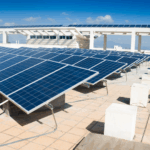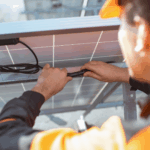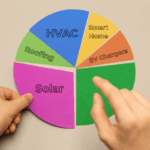
An essential component of any solar energy system is the inverter technology used. This article explores the differences between microinverters vs optimizers, two leading technologies to help homeowners make informed decisions.
Understanding these technologies’ benefits, costs, and operational mechanisms is key to optimizing your solar energy system’s performance.
Table of Contents
Microinverters
Microinverters are small inverters attached to each solar panel, converting the direct current (DC) produced by the panel into alternating current (AC) used in homes. This individualized approach means that each panel operates independently, making the system more resilient to issues like shading or panel degradation.
Microinverters are especially beneficial in challenging environmental conditions. For instance, if one panel is shaded, the others continue to perform at their peak, ensuring minimal impact on the overall system efficiency. This feature is particularly advantageous for roofs with irregular shapes or orientations or those subjected to partial shading.
Our Case Studies
Our studies in California indicate that homes with microinverters saw a 5-10% increase in energy output compared to traditional string inverter systems, particularly in areas with frequent shading.
These results highlight microinverters’ ability to adapt to varied environmental conditions, making them a robust choice for diverse settings.
Power Optimizers
Power optimizers are module-level power electronics (MLPEs) integrated into each solar panel. Like microinverters, they optimize the energy output of individual panels. However, unlike microinverters, power optimizers still rely on a central inverter to convert DC to AC. They regulate the voltage of each panel, ensuring that underperforming panels do not degrade the overall system performance.
Our Case Study
In a comparative study by our labs, power optimizers offered an efficiency improvement of around 5% in partially shaded conditions compared to traditional systems.
Their cost-effectiveness is a significant selling point, offering many of the benefits of microinverters but at a lower price. Power optimizers present a balanced solution for homeowners with tight budgets between cost and performance enhancement.
Comparative Analysis of Microinverters vs Optimizers
Direct Comparison of Microinverters and Power Optimizers
- Efficiency: Both technologies improve the efficiency of solar panels, especially in non-ideal conditions like shading. However, microinverters offer a slight edge in output maximization for each panel due to their independent inversion of DC to AC.
- Cost: Power optimizers are generally more cost-effective than microinverters. While they provide similar benefits in terms of efficiency, the initial investment and installation costs are lower. This makes them a more accessible option for homeowners with budget constraints.
- Suitability in Different Environmental Conditions: Microinverters excel in highly variable environmental conditions due to their panel-by-panel optimization. They are ideal for roofs with complex designs, varying angles, or intermittent shading. While effective in shaded conditions, power optimizers may not provide the same optimization level in complex roofing layouts.
Installation Time
The speed of installation between a string inverter system with power optimizers and a micro inverter system can vary based on several factors, including the installation’s complexity, the installers’ experience, and the specific characteristics of the site.
Microinverter systems on average are faster to install than string inverter systems with power optimizers.
- Simpler Design and Fewer Components: Micro inverter systems have a simpler design as each panel has its own inverter. This eliminates the need for a central string inverter and power optimizers attached to each panel. Fewer components and connections can streamline the installation process.
- Ease of Installation: Micro inverters are installed directly at each panel, simplifying wiring. As with string systems, there’s no need to run DC wiring from the panels to a central inverter. This can save time, especially in complex installations with multiple roof orientations or shading issues.
- Scalability and Flexibility: Micro inverters offer more flexibility in terms of system design and scalability. This can make the planning and installation process more straightforward, especially for irregular roof layouts.
- Safety Considerations: Micro inverters operate at a lower voltage compared to the high DC voltage in string systems. This can make the installation process safer and quicker, as installers may not need to take as many precautions as they would with high DC voltage systems.
It’s important to note that the specific circumstances of each installation can vary. For instance, if an installation site is particularly suited to a string inverter system (e.g., a large, unshaded roof with uniform orientation), the installation time might be comparable to a micro inverter system.
The experience and expertise of the installation team also play a crucial role in determining the installation time.
Reliability and Maintenance
Microinverters: Offer the advantage of independent operation, meaning a failure in one inverter doesn’t impact the entire system. Based on our internal claims data from over 500,000 solar energy systems, approximately 1 in 1500 microinverters fail. This low failure rate underscores their reliability and suitability for long-term use.

Power Optimizers: While dependent on the central inverter’s functionality, they demonstrate comparable reliability. Our data indicates a failure rate of about 1 in 1300 optimizers, suggesting slightly higher maintenance considerations than microinverters but still offering robust performance.

Maintenance
Microinverters with fewer centralized components tend to have lower maintenance requirements. Each unit operates independently, so a failure in one inverter doesn’t affect the entire system. While reliable, power optimizers depend on the central inverter’s functionality. In terms of warranties, microinverters often come with longer warranty periods, reflecting their durability and lower maintenance needs.
Long-term Considerations: Homeowners should consider long-term performance and maintenance. Microinverters may offer greater long-term benefits with higher upfront costs, whereas power optimizers provide a more balanced initial investment with slightly higher long-term maintenance.
Conclusion
In summary, both microinverters and power optimizers offer significant benefits for residential solar systems, enhancing efficiency and performance, particularly in challenging environmental conditions. The choice between the two ultimately depends on individual homeowner needs and specific system requirements.
- Microinverters are ideal for homes with complex roof layouts or significant shading issues, offering optimal performance by allowing each panel to operate independently. They are a great long-term investment due to their durability and lower maintenance requirements, albeit with a higher upfront cost.
- Power Optimizers are a cost-effective solution, providing many benefits of microinverters while lowering initial expenses. They are suitable for systems where budget constraints are considered without significantly compromising efficiency.
Homeowners should weigh these factors — efficiency, cost, installation complexity, and maintenance requirements — in light of their unique circumstances. Consulting with a solar energy expert can provide further personalized insights, ensuring the choice of technology aligns perfectly with your energy needs and goals.


